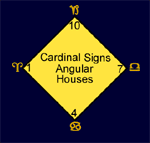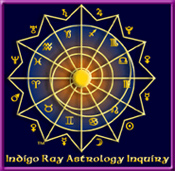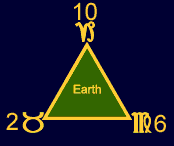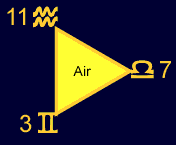|
|
|
- ACS
- Astro
Communication Services. Founded by Neil F.Michelson. Known for
their astrology software and Atlas publications. http://www.astrocom.com
|
- AFA
- American
Federation of Astrologers. Publisher of the monthly magazine,
Today's Astrologer. http://www.astrologers.com
|
- Affliction
- An
outdated term that describes either a difficult aspect (i.e. Squared
or Opposition),
or a placement of a planet or angle in a sign that does not suit
it, (i.e. Mars
in Pisces).
Also describes a relation with a "malefic
"
such as Saturn.
|
- Air
Signs
- Aquarius,
Gemini,
or Libra.
These signs are the air
signs. The air signs are usually connected with communication
and the intellect. In a natural wheel they occupy the third, seventh
and eleventh house.
-
-
|
- Angles
- Refers
to the Major angles in a chart. Includes the Ascendant
or Rising
Sign, the Descendant, which is opposite
the Ascendant, the Coeli or
Midheaven and Imum
Coeli, which is opposite the Coeli.
-
|
- Angular
Houses
- The
first, fourth, seventh, and tenth houses. These houses are
generally connected with the Cardinal signs and Cardinal
Qualities.

-
-
|
- Arabic
Parts
- A
series of sensitive points largely defined by and used by Arabic
astrologers. Usually a calculation of adding the positions of
two factors in the chart, for example: the moon and the ascendant,
and subtracting a third factor, as an example the sun. Part
of Fortune is an Arabic Part.
-
|
- Ascendant
- The
point of the zodiac that falls on the eastern horizon at the time
of the your birth. This is the same as the first
house cusp and describes your personality and character and
how you relate your world. Also known as the Rising Sign.This
is the intersection of the horizon and the ecliptic
in the East. For further information see this page.
-
|
- Aspect
- An
angular relationship between two planets, angles, etc. The angular
distance between two factors in the horoscope, in celestial longitude.
These relationships are based on harmonics and multiples. The
major aspects are Conjunct,
Trine,
Sextile,
Squared,
and Opposition,
though there are many intermediate minor aspects. These first
three aspects are generally considered to be beneficial an the
last two considered to be difficult, though the more difficult
aspects can act as teachers and help you to learn and grow.
|
- Asteroids
-
- The
Asteroids are a belt of orbiting debris of what has been speculated
as a disintegrated planet between the orbits of Mars and Jupiter.
Some astrologers believe that the belt is the remains of what
use to be Pluto and that Pluto was "exiled" to the outer
rim. The four major asteroids considered in today's astrology
are Pallas
Athene, Ceres,
Juno,
and Vesta.
There are thousands of these boulders in orbit between the Red
Planet and the Giant Planet.
|
- Astrolabe
- Tool
for recording astrological calculations.
|
- Astrologer
- A
professional who studies the positions and aspects of celestial
bodies in the belief that they have an influence of the course
of natural earthly occurrences and human affairs.
-
|
|
|
|
- Benefic
- Planets
and aspects that were thought to give positive influences. Traditionally,
Jupiter
and Venus
are the two Major Benefics (or Greater)in that order, though Mercury
and the Moon
are also considered Benefic (or Lesser). Conjunct,
Sextile
and Trine
aspects are also considered Benefic.
|

|
|
- Cadent
- The
third, sixth, ninth and twelfth houses. These are ruled by
Mutable
Signs and are generally associated with the Mutable
qualities.

|
- Campanus
- Thirteenth
century mathematician and astrologer who devised the Campanus
House
System.
|
- Cardinal
Signs
-
The
signs Aries, Cancer, Libra and Capricorn. These fall at the
Cardinal
Points of the Zodiac, with Aries beginning at the "Vernal
Equinox" or first point of Spring, or the beginning of
the Zodiac. These signs are generally associated with action
and beginnings. They are also associated with initiatory and
dynamic actions. See
also Qualities 
|
- Chiron
- A
small celestial body (planetoid) between Saturn and Uranus. Discovered
by Charles Kowal in 1977 and named for the mythical centaur noted
for healing and teaching.
-
|
- Classical
Horary Astrology
- Practice
of providing answers to current patterns or predictions (horary)
by the system devised by William Lilly in the 17th century. This
system only includes the planets discovered up to that date. Sun,
Moon, Mercury,Venus,Mars,Jupiter and Saturn.
|
- Combust
or Combustion
- When
a planet is positioned in the same sign as the Sun and is less
than 8 degrees away from the Sun, it is said to be combust. This
is a consideration in Horary
astrology. Combustion implies that the action of the planet is
weakened.
-
|
- Conjunction
- An
aspect
formed when two angles or planets are at roughly the same angle
(usually within an orb 8-10 degrees)
|
- Constellations
-
The groupings of fixed
stars, (Orion, Big Dipper,Scorpio, etc.). Twelve of these
groupings are named for the twelve sections that the Sun's path
travels in one year as appeared from the Earth. It is these twelve
sections that lend their name to the twelve signs of the
Zodiac. In Astrology, it is not the constellations that are
important it is the Sign of Zodiac.
-
|
- Contraparallel
- An
aspect in declination when two planets have (within a 1° orb)
the same degree of declination, but one is North and the other
is South. Read by most astrologers as similar to an opposition.
-
-
-
|
- Critical
degrees
- 13
and 26 degrees of Aries, Cancer, Libra and Capricorn (the Cardinal
signs). 9 and 21 degrees in Taurus, Leo, Scorpio and Aquarius
(the
Fixed signs). Also 4 and 17 degrees in Gemini, Virgo, Sagittarius,
and Pisces (the
Mutable signs). The Critical Degrees concept comes from the
Hindus. Thought to be a sensitive point that strengthens the power
of the sign.
-
|
- Current
Patterns
- ACS's
preferred term for Predictive Astrology. They prefer it because
they believe one can study various methods of moving the chart
in time and prognosticate possibilities or even probabilities.
The chart, then, shows us "patterns" which we may choose
to follow or to alter. The term "predict" suggests fated
outcomes that will happen. Thus the change to current patterns
as it includes free will. The owners of IRAI agree and use this
term throughout the web site.
|
- Cusp
- 1)
A line dividing the houses.
The beginning of an astrological wheel of house starts with the
Ascendant and moves counterclockwise. Astrology in interpretation
places great value of the beginning of the house, thus when dealing
with signs that are close to the beginning of a house it can represents
a gray area where the individual may be affected by both signs,
the preceding house and the house of entrance. This line is measured
in degrees 2) The degree of the zodiac (celestial longitude) where
one astrological sign ends and the next begins.
-
|
 |
|
- Decan,
Decanates
- A
division of the signs into 10 degrees each of which is subtly
different from one another due to the different rulers involved.
-
|
- Declination
- A
coordinate system measuring positions North or South of the celestial
equator.
-
-
|
- Descendant
- The
angle that is exactly across from the Ascendant. It is the cusp
of the seventh
house. Your descendant relates to your marriage and partnership
and interaction with others.
|
- Detriment
- Planet
in the opposite sign it rules. Indicates that it is not operating
at the full power or influence that it could. More influence of
the sign it is in rather than the qualities of the particular
planet. Can indicate a need to adhere to rules and regulations.
Example: Mars in Libra in the Natal chart would be considered
detriment because Mars rules Aries and the opposite sign of Aries
is Libra.
|
- Dignified
or Dignity
- Planet
that rules the sign it is in. Indicates a control of circumstances.
Example: Mars in the astrological sign Aries in a Natal chart
would be considered Dignified.
|
- Directions
- 1)
The North, South, East and West of the celestial and terrestrial
maps. 2) A system of studying current patterns
that moves all factors in a horoscope in an uniform amount symbolically
forward or backward in time, according to a specified arc, such
as the Solar Arc (Sun's progressed motion in one year). Another
example is the Ascendant Arc, which uses the movement of the progressed
Ascendant in a year. Generally the "directed planets"
are interpreted by comparing them with the natal planets.
-
-
|
- Dragon's
Head
- see
Moon
Nodes
|

|
|
|
Earth
Signs
The
signs of Taurus,
Virgo,
and Capricorn.
These signs represent 'Earthly'
qualities such as stability, responsibility, and practicality.
In the natural wheel they occupy the second, sixth and tenth house.
|
- East
Point
- The
angle which is rising over the eastern horizon at the earth's
equator at any time. A sensitive point defined as 90° East
of the intersection of the meridian
with the ecliptic; used by some astrologers as the an auxiliary
Ascendant. Should more correctly be called the Equatorial Ascendant,
but the term East Point is the most common.
|
- Easy
Aspects or Soft Aspects
- A
harmonious and easily flowing aspect such as Conjunct,
Trine
or Sextile
and Quintile. For in depth
information on the aspects, please visit Lesson
4.
|
- Eclipse
- An
eclipse is the partial or total obscuring of one of the luminaries
by the shadow of the other. At the same time, either or both luminaries
are within orb of an aspect to the Lunar Nodes. The Eclipse is
considered a Solar Eclipse when the Sun and Moon are conjunct
otherwise known as a New Moon. It is considered a Lunar Eclipse
when the Sun and Moon are in opposition or a Full Moon.
-
|
- Ecliptic
- The
orbit of the Sun and all the planets
around the Earth: the celestial circle that the Sun, as seen from
the Earth, seems to follow within the span of a year.
|
- Electional
Astrology
- Refers
to the method of "electing" or choosing in advance,
a time that is astrologically favorable. One erects a chart for
a time in which the current patterns would be interpreted as indicating
success in the anticipated activity (such as an opening of business,
getting married, etc.) and then the individuals concerned strive
to cause the event to happen at that exact time.
|
- Elements
- Air
 ,
Water ,
Water ,
Earth ,
Earth and Fire
and Fire . .
|
- Ephemeris
- Pronounced
"eh-FEM-er-is". A book that supplies the positions of
the Sun, Moon and Planets, usually daily. Positions are usually
given in celestial longitude, latitude and declination. Noted
are the eclipses and the ingresses
of each planet, the Moon Nodes and Sidereal Time. Plural is referred
to as ephemerides. They are usual for Noon or Midnight Greenwich
Time. To view this month's midnight ephemeris of Central Daylight
Savings time click here.
|
- Equal
House System
- The
system that takes the first house being the Ascendant
and dividing the remaining 11 houses into equal 30 degrees slices.
The Midheaven House
system starts with the Coeli or Midheaven being the cusp of
the 10th house and dividing the other 11 house as equal 30 degree
slices.
|
- Equatorial
Ascendant (EQ)
- See
East Point
-
|
- Exalted
- Planet
energies that are expressed harmoniously with complementary forces
and display increased virtues that are magnified. The Planet feels
comfortable in this friend's home. Example: Mars is a guest in
Capricorn in the Natal chart and excels while visiting.
|



